Snowmobile: Difference between revisions
m r2.7.1) (Robot: Adding lt:Sniego rogės |
|||
| Line 36: | Line 36: | ||
The challenges of transporting people and their possessions cross-country during the winter season drove the invention of the snowmobile, an all-terrain vehicle specifically designed for travel across deep snow where other vehicles floundered. During the 20th century, rapidly evolving designs produced machines that were most commonly two-person tracked vehicles powered by gas engines that enabled them to tow a sled or travel, initially at low-to-moderate speeds, depending on snow conditions, terrain and the presence of obstacles protruding above the snow, including brush and trees. Originally utility vehicles, many manufacturers now provide a full range of recreational. special-purpose, and competition versions. Where early designs had {{convert|10|hp}} two-stroke engines, there has been a move toward newer style 2-stroke and 4-stroke gas engines, some with over {{convert|150|hp|abbr=on}}. |
The challenges of transporting people and their possessions cross-country during the winter season drove the invention of the snowmobile, an all-terrain vehicle specifically designed for travel across deep snow where other vehicles floundered. During the 20th century, rapidly evolving designs produced machines that were most commonly two-person tracked vehicles powered by gas engines that enabled them to tow a sled or travel, initially at low-to-moderate speeds, depending on snow conditions, terrain and the presence of obstacles protruding above the snow, including brush and trees. Originally utility vehicles, many manufacturers now provide a full range of recreational. special-purpose, and competition versions. Where early designs had {{convert|10|hp}} two-stroke engines, there has been a move toward newer style 2-stroke and 4-stroke gas engines, some with over {{convert|150|hp|abbr=on}}. |
||
=== Multi-passenger snowmobiles === |
=== Multi-passenger snowmobiles ===poopy |
||
{{Main|Aerosan|Snowcat}} |
{{Main|Aerosan|Snowcat}} |
||
Revision as of 18:57, 12 January 2012

A snowmobile, also known in some places as a snowmachine,[1] or sled,[2] [3] is a land vehicle for winter travel on snow. Designed to be operated on snow and ice, they require no road or trail. Design variations enable some machines to operate in deep snow or forests; most are used on open terrain, including frozen lakes, or driven on paths or trails. Usually designed to accommodate a driver and one passenger, their use is much like a motorcycle and an all-terrain vehicle (ATVs) intended for winter use on snow-covered ground and frozen ponds and waterways. They have no enclosure except for a windshield and their engine normally drives a continuous track or tracks at the rear; skis at the front provide directional control.
Early snowmobiles used rubber tracks, but modern snowmobiles typically have tracks made of a Kevlar composite. Originally snowmobiles were typically powered by two-stroke gasoline/petrol internal combustion engines. Four-stroke engines are becoming more and more common in snowmobiles, primarily to address environmental complaints.
Originally intended as a winter utility vehicle to be used where other vehicles cannot go, they appealed to hunters and workers transporting personnel and material across snow-covered land, frozen lakes and rivers. In the latter part of the 20th century, they have been put to use for recreational purposes as well. People who ride them commonly are known as snowmobilers. The contemporary types of recreational riding forms are known as snowcross/racing, trail riding, freestyle, mountain climbing, boondocking, carving, ditchbanging and grass drags. Summertime activities for snowmobile enthusiasts include drag racing on grass, asphalt strips, or even across water.
History
Introduction
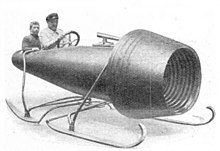
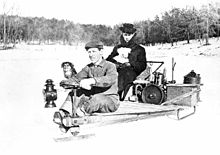
The challenges of transporting people and their possessions cross-country during the winter season drove the invention of the snowmobile, an all-terrain vehicle specifically designed for travel across deep snow where other vehicles floundered. During the 20th century, rapidly evolving designs produced machines that were most commonly two-person tracked vehicles powered by gas engines that enabled them to tow a sled or travel, initially at low-to-moderate speeds, depending on snow conditions, terrain and the presence of obstacles protruding above the snow, including brush and trees. Originally utility vehicles, many manufacturers now provide a full range of recreational. special-purpose, and competition versions. Where early designs had 10 horsepower (7.5 kW) two-stroke engines, there has been a move toward newer style 2-stroke and 4-stroke gas engines, some with over 150 hp (110 kW).
=== Multi-passenger snowmobiles ===poopy

The origin of the snowmobile is not the work of any one inventor but more a process of advances in engines for the propulsion of vehicles and supporting devices over snow. It parallels the development of the automobile and later aviation, often inventors using the same components for a different use.
Wisconsinites experimented with over-snow vehicles before 1900, trying bicycles on runners with gripping fins, steam-propelled sleighs and later Model T Fords converted with rear tractor treads and skis in front. In the first races held near Three Lakes in 1926, 104 of these "snowbuggies" started. Carl Eliason of Sayner developed the prototype of the modern snowmobile in 1924 when he mounted a small gasoline-powered marine engine on a long toboggan, steered with skis under the front and driven by a rear, single, endless track. Patented in 1926, Eliason made 40 snowmobiles. Upon receiving an order for 200 from Finland, he sold his patent to the FWD Company of Clintonville. They made 300 for military use, then transferred the patent to a Canadian subsidiary.
The Aerosan, propeller-driven and running on skis, was built in 1909–1910 by the Russian inventor Igor Sikorsky.[4] Aerosans were used by the Soviet Red Army during the Winter War and the Second World War[5] There is some dispute over whether Aerosans should be considered snowmobiles, as they are not propelled by tracks, but if they are, they would be the first snowmobiles developed.[6][7][8]
Adolphe Kégresse designed an original caterpillar tracks system, called the Kégresse track, while working for Tsar Nicholas II of Russia between 1906 and 1916. These used a flexible belt rather than interlocking metal segments and could be fitted to a conventional car or truck to turn it into a half-track, suitable for use over soft ground, including snow. Conventional front wheels and steering were used but the wheel could be fitted with skis as seen in the upper right image. He applied it to several cars in the Royal garage including Rolls-Royce cars and Packard trucks. Although this was not a snowmobile, it could be thought as one of the ancestor of the modern concept.
The first United States patent for a snow-vehicle using the now recognized format of rear track(s) and front skis was issued to Ray H. Muscott of Waters, MI on June 27, 1916 with U.S. Patent # 1,188,981. Many individuals later modified Ford Model Ts with the undercarriage replaced with tracks and skis following this design. They were popular for rural mail delivery for a time. The common name for these conversion of cars and small trucks was Snowflyers. These vehicles were extremely popular in the northern reaches of Canada. [9]
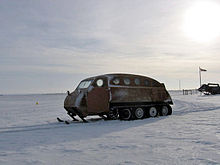

The relatively dry snow conditions of the United States Midwest suited the converted model Ts and other like vehicles but they were not suitable for operation in more humid snow areas such as Southern Quebec and New England. This led Joseph-Armand Bombardier of the small town of Valcourt in Quebec, Canada, to invent a different caterpillar track system suitable for all kinds of snow conditions. Bombardier had already made some "metal" tracked vehicles since 1928, but his new revolutionary track traction system (a toothed wheel covered in rubber, and a rubber and cotton track that wraps around the back wheels) was his first major invention. He started production of a large, enclosed, seven-passenger snowmobile in 1937, the B-7 and introduced another enclosed twelve-passenger model, the B-12 in 1942. The B-7 had a V-8 flathead engine from Ford Motor Company. The B-12 had a flathead in line six cylinder engine from Chrysler industrial, and 2,817 units were produced until 1951. It was used in many applications, such as ambulances, Canada Post vehicles, winter "school buses", forestry machines and even army vehicles in World War II. Bombardier had always dreamed of a smaller version, more like the size of a motor scooter.
Individual snowmobiles

Numerous people had ideas for a smaller personal snowmobile. In 1914, O.M. Erickson and Art Olsen of the P.N. Bushnell company in Aberdeen, South Dakota built an open two-seater "motor-bob" out of an Indian motorcycle modified with a cowl-cover, side by side seating, and a set of sled-runners fore and aft. While it did not have the tracks of a true snowmobile, its appearance was otherwise similar to the modern version and is one of the earliest examples of a personal motorized snow-vehicle.[10][page needed] Edgar and Allen Hetteen and David Johnson of Roseau, Minnesota were among the first to build a practical snowmobile in 1955–1956, but the early machines were heavy (1,000 lb (450 kg)*) and slow (20 mph (32 km/h)*). Their company, Hetteen Hoist & Derrick Co., became Polaris Industries, a small snowmobile manufacturer.[11]
It was only in 1960, when engines became lighter and smaller than before, that Bombardier invented what we know as the modern snowmobile in its open-cockpit one- or two-person form, and started selling it as the "Ski-doo". Competitors sprang up and copied and improved his design. In the 1970s there were over a hundred snowmobile manufacturers.[12] From 1970 to 1973 they sold close to two million machines, a sales summit never since equalled, with a peak of half a million in 1971.[12] Many of the snowmobile companies were small outfits and the biggest manufacturers were often attempts by motorcycle makers and outboard motor makers to branch off in a new market.
Most of these companies went bankrupt during the gasoline crisis of 1973 and succeeding recessions, or were bought up by the larger ones. Sales rebounded to 260,000 in 1997 but went down gradually afterward, influenced by warmer winters and the use during all four seasons of small one- or two-person ATVs. The snowmobile market is now divided up between the four large North American makers (Bombardier Recreational Products (BRP), Arctic Cat, Yamaha, Ski-doo and Polaris) and some specialized makers like the Quebec-based AD Boivin (manufacturer of the Snow Hawk[13]) and the European Alpina Snowmobiles.[12][14]
Some of the higher powered modern snowmobiles can achieve speeds in excess of 150 mph (240 km/h). Drag racing snowmobiles can reach speeds in excess of 200 mph (320 km/h).

Snowmobiles are widely used in arctic territories for travel. However, the small population of the Arctic areas makes for a correspondingly small market. Most of the annual snowmobile production is sold for recreational purposes much farther south, in those parts of North America where the snow cover is stable during the winter months. The number of snowmobiles in Europe and other parts of the world is relatively low, though they are growing rapidly in popularity. In northern Sweden, for instance, some families now own as many as five snowmobiles.[citation needed]
Snowmobiles designed to perform various work tasks have been available for many years with dual tracks from such manufacturers as Aktiv (Sweden), who made the Grizzly, Ockelbo (Sweden), who made the 8000, and Bombardier who made the Alpine and later the Alpine II. Currently there are two manufacturers of dual-track snowmobiles; Russia's Buran[citation needed] and the Italian Alpina Snowmobiles (under the name Sherpa).
An odd version of snowmobile is the Swedish Larven made by Lenko in Östersund from the 1960s until the end of the 1980s. It was a very small and basic design with just an engine in the rear and a track. The driver sat on it and steered using skiis on his feet.[15]
Propulsion
Today[when?], most snowmobiles are powered by either a 4 or 2-stroke internal combustion engine. However, an electrochemical battery-powered version has been made by McGill University.[16] The engineers/students at McGill University are also working on a hybrid version of their snowmobile.
Performance
Performance of snowmobiles has improved exponentially[peacock prose] since their inception with a sharp spike in performance in the last 15 or so years[when?]. The first snowmobiles made way with as little as 5 horsepower (3.7 kW) engines. Engine size and efficiency has grown considerably in the last 15 years[when?]. In the early 1990s, the biggest engines available (typically 600-650cc range) produced in the neighborhood of 115 hp (86 kW). Today[when?] several late model snowmobiles are available with engines sizes up to 1200 cc, producing 150+ hp, as well as several models with up to 1000 cc engines producing closer to 180 hp (130 kW). Snowmobiles are capable of moving across steep hillsides without sliding downslope if the rider transfers their weight towards the uphill side.
Mountain sleds permit access in remote areas with deep snow, which was nearly impossible a few decades ago. This is mainly due to alterations, enhancements, and additions of original trail model designs such as weight, weight distribution, track length, paddle depth, and power. Technology and design advances in mountain snowmobiles have skyrocketed[peacock prose] since 2003 with Ski-Doo's introduction of the "REV" framework platform. Since then, all mountain snowmobile manufacturers have increased performance drastically[peacock prose]. Most 2-stroke mountain snowmobiles have a top engine size of 800 cc's producing around 150 hp (110 kW), although some 1000 cc factory machines have been produced. These may not be as popular as many 800 cc models outperform them due to weight and an increase of unneeded power.
Cornices and other kinds of jumps are sought after for aerial maneuvers. Riders often search for un-tracked, virgin terrain and are known to "trailblaze" or "boondock" deep into remote territory where there is absolutely no visible path to follow. However, this type of trailblazing is not without hazards: Contact with buried rocks, logs and even frozen ground, can cause extensive damage to snowmobiles and injuries to the riders. Riders will often look for large open fields of fresh snow where they can carve. Some riders use extensively modified snowmobiles, customized with aftermarket accessories such as handle bar risers, handguards, custom/lightweight hoods, windshields, and seats, running board supports, studs, and numerous other modifications that increase power and maneuverability. Many of these customizations can now be purchased straight off the showroom floor on stock models.
Trail snowmobiles have had their fair share of improvements in the past 15 years[when?] as well (many of them borrowed from endeavors to produce winning mountain sleds). Heavy 'muscle sleds' can produce speeds in excess of 150 mph (240 km/h) due to powerful engines (up to 1200 cc stock, and custom engines exceeding 1200 cc), short tracks, and good traction on groomed trails. Sno-cross oriented snowmobiles often have a engine size cap of 440 or 600 cc, but lighter machines with redesigned stances, formats, and weight control have produced extremely fast and quickly accelerating race sleds.
Environmental impact
The environmental impact of snowmobiles has been the subject of much debate. Governments have been reacting slowly to noise and air pollution, partly due to lobbying from manufacturers and users of snowmobiles. For instance, in 1999, the Canadian government adopted the Canadian Environmental Protection Act, but the set of rules governing pollution emissions for off-road vehicles was only released in January 2005.[17] Another example of regulation, only four-stroke snowmobiles are allowed in Yellowstone National Park since a bylaw was recently passed to minimize CO2 emissions and noise.[18] In Yellowstone, snowmobiles account for 80% of total hydrocarbons emissions and 50% of carbon monoxides emissions during the winter months. Although less than 2% and 1% overall annually respectively. In winter, snowmobiles only are allowed to ride on the unplowed roads used in the summer in the park. This impact accounts for less than 1% (.002%) of the park area.
Air
Most snowmobiles are still powered by two-stroke engines, although Alpina Snowmobiles and Yamaha have been using four-strokes respectively since 2002 and 2003. However, in the last decade several manufacturers have been successful in designing less polluting motors, and putting most of them in production. Yamaha and Arctic-Cat were the first to mass produce four-stroke models, which are significantly less polluting than the early two-stroke machines. Alpina offers a 4-stroke EFI engine equipped with a catalytic converter and state of the art dual oxygen-probe. Bombardier's E-Tec two-stroke motors emit 85 percent less pollutants than previous carburated 2-strokes. Polaris has developed a fuel-injection technology called "Cleanfire Injection" on their 2 strokes. The industry is also working on direct injected "clean two strokes" which are actually an improvement on carbureted four strokes in terms of NOX emissions.
Independent researchers are also working on the air pollution issue. Even undergraduate and graduate students are participating in contests to lessen the impact of emissions from snowmobiles. The Clean Snow Mobile Challenge is held yearly at Michigan Technological University regrouping the entries from universities from across United States and Canada.[19] Some of the participants in recent years have been the École polytechnique de Montréal with a quasiturbine engine[20] and students from École de technologie supérieure of the UQAM with a less polluting two-stroke engine using E85 and direct injection.[21]
Noise
Maximum noise restrictions have been enacted by law for both production snowmobiles and aftermarket components. For instance, in Quebec (Canada) noise levels have to be 78 decibels or less at 20 meters from a snowmobile path.[22] Now in 2009, snowmobiles produce 90% less noise than in the 1960s.[14] However, noise has cumulative effects on users and people living near those trails that are not well researched. It is still the origin of numerous complaints.[23] Efforts in regard to noise reduction have now generally shifted to suppressing mechanical noise of the suspension components and tracks.[22] Arctic Cat in 2005 introduced "Silent Track technology" on touring models such as the T660 Turbo, And Bearcat. Some M-Series sleds also had this. Ski-doo has since then also used comparative "silent track technology" on some production models.
A common dispute among the snowmobile community is about the use of aftermarket exhaust systems, commonly known as "cans" or "silencers". These replace the stock muffler with a less restrictive system that is usually claimed to increase power output of the engine. However, these aftermarket exhausts are often much louder than stock, with some being only slightly quieter than a completely open, unbaffled system. Most, if not all local snowmobile clubs(that maintain and groom trail systems) discourage the use of these systems due to landowner complaints about their noise and subsequent revoking of trail use rights through their property. Local and state authorities have been setting up checkpoints on high traffic trails, checking for excessively loud systems and issuing citations when found. Typically these systems are installed on 2 stroke powered machines(giving the distinctive "braap" sound), however in recent years aftermarket companies have released silencers for 4 stroke models as well.
Terrain and wild life
Scientific studies have shown that damage is caused to the terrain on or around heavily used snowmobile paths. The snow becomes compacted and any winter rain may flood surrounding areas. This hard snow is more thermally conductive and the underlying ground will freeze to a greater depth, possibly affecting plants and leading to erosion of soil in the spring. Furthermore, snowmobiles can damage shoots and saplings they pass over.[22] Effects on animals are more difficult to assess; some studies suggest that animals stay away from the snowmobile trails due to the noise, others indicate that some animals are actually using these trails when there is little traffic.[22] Invasive species may use those paths to spread, such as in Utah, where coyotes are encroaching into lynx habitat.[24]
Economic
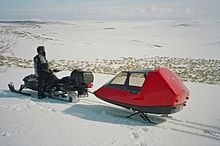
According to the International Snowmobile Manufacturers Association, Snowmobilers in Canada and the United States spend over $28 billion on snowmobiling each year. This includes expenditures on equipment, clothing, accessories, snowmobiling vacations (lodging, fuel, and food), maintenance, etc. Often, this is the only source of income for some smaller towns that rely solely on tourism during the summer and winter month.[25]
Accidents and safety
Due to their inherent maneuverability, acceleration and top speed capabilities, it requires skill and physical strength to operate a snowmobile.
Snowmobiling injuries and fatalities are higher than those caused by on road motor vehicle traffic.[26][27] Losing control of a snowmobile could easily cause extensive damage, injury, or death. A common cause of accidents is when a rider loses control because they do not have an adequate grip and do not realize how powerful it is. This sometimes results in the now rider-less sled crashing into objects such as a rock or a tree. Some snowmobiles are fitted with lanyards connected to a kill switch, to prevent this type of accident. However, not all riders use this device.
It is also possible for a rider, for various reasons to lose control, veer off a trail and roll the snowmobile and/or crash directly into a rock or tree. In areas they are unfamiliar with, riders could drive into suspended barbed wire or haywire fences at high speeds – there have been a number of serious/fatal accidents caused in this way.
Each year, riders are killed when they crash into other snowmobiles, automobiles, pedestrians, rocks, trees, or by falling through ice. About 10 people a year die in such crashes in Minnesota alone with alcohol a contributing factor in many (but not all) cases[citation needed]. In Saskatchewan, 16 out of 21 deaths in snowmobile collisions between 1996 and 2000 were alcohol-related.[28][29][30] Wrestler Lindsey Durlacher died in 2011 following surgery for a broken sternum he sustained in a snowmobile accident.[31]
Fatal collisions with trains can also occur when a snowmobiler indulges in the illegal practice of "rail riding", riding between railroad track rails over snow covered sleepers. Inability to hear oncoming trains over the engine noise of the snowmobile makes this activity extremely dangerous. Another cause of serious injury or death is colliding with large animals such as moose and deer that may venture onto snowmobile trails. Most such encounters occur at night or in low visibility conditions when the animal cannot be seen in time to avoid a collision. Also even when successful, a sudden maneuver to avoid the animal could still result in the operator losing control of the snowmobile.
A large number of snowmobile-related deaths in Alaska are caused by drowning.[citation needed]. Because of the extreme cold in many parts of Alaska the rivers and lakes are frozen over for a large part of the winter. People riding early or late in the season run the risk of falling through unstable ice, and heavy winter clothing can make it extremely difficult to escape the frozen water. The next leading cause of injury and death is avalanches,[citation needed] which can result from the practice of Highmarking, or driving a snowmobile as far up a hill as it can go. Risks can be reduced through education, proper training, appropriate gear and attention to published avalanche warnings.
Types of races
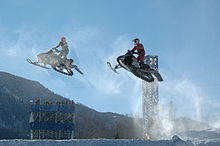
- The International 500 is a large racing event held annually in Sault Sainte Marie, Michigan. It is a 500-mile (800 km) race on a track, with the current purse being in excess of $40,000.00 usd. It has been running since February 1969, and continues to excite those attending the race to date.
- Grass drags are held every summer to fall (autumn), with the largest event being Hay Days in North Branch, Minnesota. Hay Days has always been the first weekend following the Labor Day Holiday.
- The World Championship Watercross or Snowmobile skipping races are held in Grantsburg, Wisconsin in July. The snowmobiles are raced on a marked course, similar to motocross courses, without the ramps and on water.
- The Snocross racing series are snowmobile races on a motocross-like course. The races are held during the winter season in Northern United States and Canada. One of the largest in New England is the Northeast SnoX Challenge held early January of each year in Malone, New York and run by Rock Maple Racing and sponsored by the Malone Chamber of Commerce.
- Snowmobiles are used for ice racing. The racing is held on an "Ice Oval" track. The World Championship Snowmobile Derby is held each winter in Eagle River, Wisconsin.
- The "Iron Dog", the longest snowmachine race in the world, is held annually in Alaska. It is 1,971 miles (3,172 km) long and runs from Wasilla to Nome to Fairbanks. Its name refers to Dog Mushing, long popular in Alaska.
- Vintage snowmobiling is the racing of vintage snowmobiles and has grown in popularity as a sporting event on the Canadian prairie and in America.
- The World Championship Hill Climb competition is held in Jackson, WY at the Snow King ski resort each year in March.
See also
- Other related
References
- ^ University of Oregon Slang Dictionary (2002). "Snowmachine". Retrieved 25 Mar. 2009.
{{cite web}}: Check date values in:|accessdate=(help)CS1 maint: postscript (link) - ^ University of Oregon Slang Dictionary (2002). "Sled". Retrieved 25 Mar. 2009.
{{cite web}}: Check date values in:|accessdate=(help)CS1 maint: postscript (link) - ^ sledspace.com (2008). "Sledspace – Snowmobile Community". Retrieved 18 Apr. 2011.
{{cite web}}: Check date values in:|accessdate=(help)CS1 maint: postscript (link) - ^ "The Propeller-Driven Sleigh". SelfSite. 26 July 2005. Retrieved 2008-09-10.
- ^ Valeri Potapov Translated by: James F. Gebhardt (1998). "Soviet Combat Snowmobiles". The Russian Battlefield. Retrieved 2008-09-10.
- ^ "Enjoying A Snowmobile At Full". Journal-a-day. December 18, 2006. Retrieved 2008-03-01.
Not only are snowmobiles popular in the United States and Canada, Ussr has their very own version of the snowmobile, which can be seen in the aerosan. Aerosan, when interpreted, intends "aero sleigh." The Russians usage this propeller-powered snowmobile for delivering the mail, patrolling the metes, as well as for recreational intents
- ^ "Soviet Aerosan RF 8 (for 3D Studio Max)". Vanishing Point. Retrieved 2008-03-01.
An aerosan (Russian: aerosani, literally 'aerosled') is a type of propeller-powered snowmobile, running on skis, used for communications, mail deliveries, medical aid, emergency recovery and border patrolling in northern Russia, as well as for recreation. Aerosans were used by the Soviet Red Army during the Winter War and the Second World War
- ^ On this site, they tell you to go to Snowmobile when you search for Aerosan
- ^ "Snowflyers Replace Dogs in Frozen North" Popular Mechanics, December 1934
- ^ Aberdeen American News 1914-02-04
- ^ "Polaris Company history". Archived from the original on July 18, 2007. Retrieved 2007-08-11.
- ^ a b c Transclusion error: {{En}} is only for use in File namespace. Use {{lang-en}} or {{in lang|en}} instead. "Industry Highs and Lows". Musée J-Armand Bombardier. 2003. Retrieved 2007-04-23.
- ^ Transclusion error: {{En}} is only for use in File namespace. Use {{lang-en}} or {{in lang|en}} instead. "Snow Hawk". AD Boivin. 2003. Retrieved 2008-09-05.
- ^ a b Transclusion error: {{En}} is only for use in File namespace. Use {{lang-en}} or {{in lang|en}} instead. "Snowmobiling Facts". International Snowmobile Manufacturers Associations. 2006. Retrieved 2007-04-23. Cite error: The named reference "ISMA-stat" was defined multiple times with different content (see the help page).
- ^ "Larsen Klubben". Retrieved 2007-10-08.
- ^ McGill University Electric Snowmobile Prototype "Wendigo"
- ^ Transclusion error: {{En}} is only for use in File namespace. Use {{lang-en}} or {{in lang|en}} instead. Environment Canada. "Vehicle and Engine Regulations". Gouvernment of Canada. Retrieved 2007-04-29. [dead link]
- ^ "Cleaner, Quieter Snowmobiles Approved For Use In Yellowstone National Park This Winter" (PDF). Archived from the original (PDF) on July 10, 2008. Retrieved 2008-10-22.
- ^ Transclusion error: {{En}} is only for use in File namespace. Use {{lang-en}} or {{in lang|en}} instead. "Clean Snowmobile Challenge". Keewenaw research Center. Retrieved 2007-05-01.
- ^ Template:Fr CHAPELIER Erwan, DE FIGUEIREDO Christian et PRADO Pascal. "Moteur Quasiturbine". École polytechnique de Montréal. Retrieved 2007-04-29.
- ^ Template:Fr "Motoneige écologique". Club étudiant scientifique. École de technologie supérieure de l'université du Québec. Archived from the original on 2007-09-29. Retrieved 2007-05-01.
- ^ a b c d Template:Fr "Les ravages de la motoneige". Émission Découverte. Société Radio-Canada. Retrieved 2007-05-01.
- ^ Template:Fr "Étouffons ce bruit agressant". Comité de protection de l'environnement de Québec. Retrieved 2007-04-30.
- ^ Linnell, J.D.C., J.E. Swenson, R. Andersen, and B. Barnes. 2000. How vulnerable are denning bears to disturbance? Wildlife Society Bulletin 28:400–413
- ^ ISMA (International Snowmobile Manufacturers Association)
- ^ Hortemo GS, Brattebø G, Hellesnes S (1990). "[The snowmobile—only for fun? Registration of snowmobile accidents in Western Finnmark 1988–89]". Tidsskr. Nor. Laegeforen. (in Norwegian). 110 (10): 1196–8. PMID 2333642.
{{cite journal}}: Unknown parameter|month=ignored (help)CS1 maint: multiple names: authors list (link) - ^ Landen MG, Middaugh J, Dannenberg AL (1999). "Injuries associated with snowmobiles, Alaska, 1993–1994". Public Health Rep. 114 (1): 48–52. doi:10.1093/phr/114.1.48. PMC 1308343. PMID 9925171.
{{cite journal}}: CS1 maint: multiple names: authors list (link) - ^ [1][dead link]
- ^ Beirness DJ (2001). "Alcohol involvement in snowmobile operator fatalities in Canada" (PDF). Can J Public Health. 92 (5): 359–60. PMID 11702489.
- ^ Stewart RL, Black GB (2004). "Snowmobile trauma: 10 years' experience at Manitoba's tertiary trauma centre" (PDF). Can J Surg. 47 (2): 90–4. PMID 15132460.
We identified 480 injuries in 294 patients, and 81 (27.6%) of these patients died. Collisions accounted for 72% of the injury mechanisms. Of the injuries sustained, 31% occurred on roads. Excessive speed was a risk factor in 54% of patients, suboptimal lighting in 86% and a blood alcohol level greater than 0.08 in 70%.
{{cite journal}}: Unknown parameter|month=ignored (help) - ^ [2]
- Descarries, Eric. "Autoneiges Bombardier: Des patenteux perpétuent la tradition". in La Presse. Monday, March 13, 2006.
- MacDonald, Larry. The Bombardier story : planes, trains, and snowmobiles. Toronto : J. Wiley, 2001.
- SLEDtv.org – Snowmobile Television – Snowmobile Statistics
